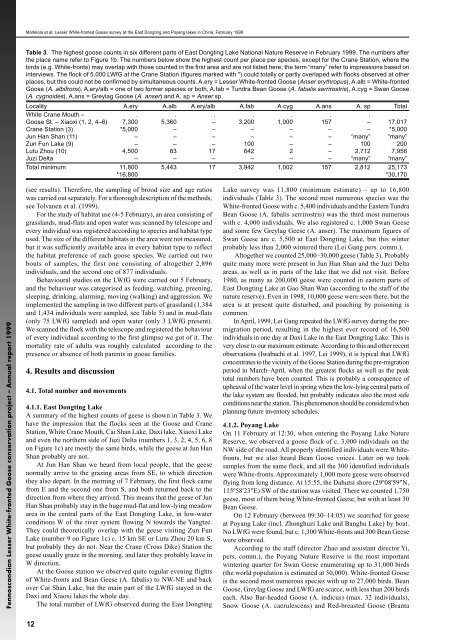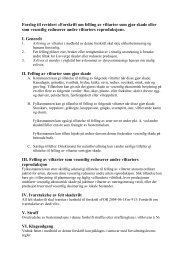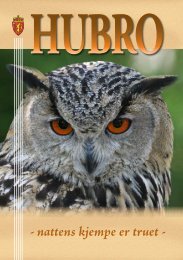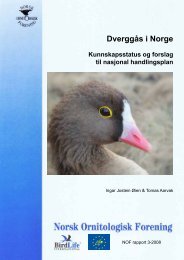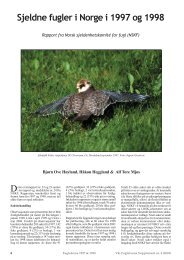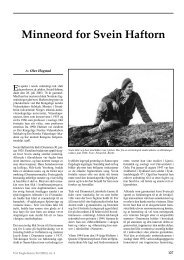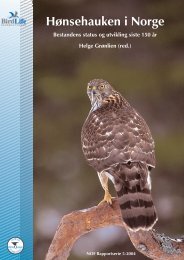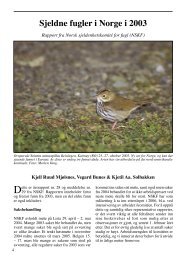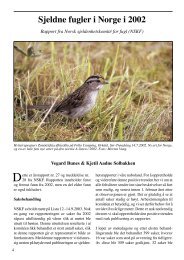Fennoscandian Lesser White-fronted Goose conservation project ...
Fennoscandian Lesser White-fronted Goose conservation project ...
Fennoscandian Lesser White-fronted Goose conservation project ...
You also want an ePaper? Increase the reach of your titles
YUMPU automatically turns print PDFs into web optimized ePapers that Google loves.
<strong>Fennoscandian</strong> <strong>Lesser</strong> <strong>White</strong>-<strong>fronted</strong> <strong>Goose</strong> <strong>conservation</strong> <strong>project</strong> – Annual report 1999<br />
Markkola et al: <strong>Lesser</strong> <strong>White</strong>-<strong>fronted</strong> <strong>Goose</strong> survey at the East Dongting and Poyang lakes in China, February 1999<br />
Table 3. The highest goose counts in six different parts of East Dongting Lake National Nature Reserve in February 1999. The numbers after<br />
the place name refer to Figure 1b. The numbers below show the highest count per place per species, except for the Crane Station, where the<br />
birds (e.g. <strong>White</strong>-fronts) may overlap with those counted in the first area and are not listed here; the term “many” refer to impressions based on<br />
interviews. The flock of 5,000 LWfG at the Crane Station (figures marked with *) could totally or partly overlaped with flocks observed at other<br />
places, but this could not be confirmed by simultaneous counts. A.ery = <strong>Lesser</strong> <strong>White</strong>-<strong>fronted</strong> <strong>Goose</strong> (Anser erythropus), A.alb = <strong>White</strong>-<strong>fronted</strong><br />
<strong>Goose</strong> (A. albifrons), A.ery/alb = one of two former species or both, A.fab = Tundra Bean <strong>Goose</strong> (A. fabalis serrirostris), A.cyg = Swan <strong>Goose</strong><br />
(A. cygnoides), A.ans = Greylag <strong>Goose</strong> (A. anser) and A. sp = Anser sp.<br />
Locality A.ery A.alb A.ery/alb A.fab A.cyg A.ans A. sp Total<br />
<strong>White</strong> Crane Mouth – . . . . . . . .<br />
<strong>Goose</strong> St. – Xiaoxi (1, 2, 4–6) 7,300 5,360 – 3,200 1,000 157 – 17,017<br />
Crane Station (3) *5,000 – – – – – – *5,000<br />
Jun Han Shan (11) – – – – – – “many” “many”<br />
Zun Fun Lake (9) – – – 100 – – 100 200<br />
Lutu Zhou (10) 4,500 83 17 642 2 – 2,712 7,956<br />
Juzi Delta – – – – – – “many” “many”<br />
Total minimum 11,800 5,443 17 3,942 1,002 157 2,812 25,173<br />
*16,800 *30,170<br />
(see results). Therefore, the sampling of brood size and age ratios<br />
was carried out separately. For a thorough description of the methods,<br />
see Tolvanen et al. (1999).<br />
For the study of habitat use (4-5 February), an area consisting of<br />
grasslands, mud-flats and open water was scanned by telescope and<br />
every individual was registered according to species and habitat type<br />
used. The size of the different habitats in the area were not measured,<br />
but it was sufficiently available area in every habitat type to reflect<br />
the habitat preference of each goose species. We carried out two<br />
bouts of samples, the first one consisting of altogether 2,896<br />
individuals, and the second one of 877 individuals.<br />
Behavioural studies on the LWfG were carried out 5 February,<br />
and the behaviour was categorised as feeding, watching, preening,<br />
sleeping, drinking, alarming, moving (walking) and aggression. We<br />
implemented the sampling in two different parts of grassland (1,384<br />
and 1,434 individuals were sampled, see Table 5) and in mud-flats<br />
(only 75 LWfG sampled) and open water (only 3 LWfG present).<br />
We scanned the flock with the telescope and registered the behaviour<br />
of every individual according to the first glimpse we got of it. The<br />
mortality rate of adults was roughly calculated according to the<br />
presence or absence of both parents in goose families.<br />
4. Results and discussion<br />
4.1. Total number and movements<br />
4.1.1. East Dongting Lake<br />
A summary of the highest counts of geese is shown in Table 3. We<br />
have the impression that the flocks seen at the <strong>Goose</strong> and Crane<br />
Station, <strong>White</strong> Crane Mouth, Cai Shan Lake, Daxi lake, Xiaoxi Lake<br />
and even the northern side of Juzi Delta (numbers 1, 3, 2, 4, 5, 6, 8<br />
on Figure 1c) are mostly the same birds, while the geese at Jun Han<br />
Shan probably are not.<br />
At Jun Han Shan we heard from local people, that the geese<br />
normally arrive to the grazing areas from SE, to which direction<br />
they also depart. In the morning of 7 February, the first flock came<br />
from E and the second one from S, and both returned back to the<br />
direction from where they arrived. This means that the geese of Jun<br />
Han Shan probably stay in the huge mud-flat and low-lying meadow<br />
area in the central parts of the East Dongting Lake, in low-water<br />
conditions W of the river system flowing N towards the Yangtze.<br />
They could theoretically overlap with the geese visiting Zun Fun<br />
Lake (number 9 on Figure 1c) c. 15 km SE or Lutu Zhou 20 km S,<br />
but probably they do not. Near the Crane (Cross Dike) Station the<br />
geese usually graze in the morning, and later they probably leave in<br />
W direction.<br />
At the <strong>Goose</strong> station we observed quite regular evening flights<br />
of <strong>White</strong>-fronts and Bean Geese (A. fabalis) to NW-NE and back<br />
over Cai Shan Lake, but the main part of the LWfG stayed in the<br />
Daxi and Xiaoxi lakes the whole day.<br />
The total number of LWfG observed during the East Dongting<br />
12<br />
Lake survey was 11,800 (minimum estimate) – up to 16,800<br />
individuals (Table 3). The second most numerous species was the<br />
<strong>White</strong>-<strong>fronted</strong> <strong>Goose</strong> with c. 5,400 individuals and the Eastern Tundra<br />
Bean <strong>Goose</strong> (A. fabalis serrirostris) was the third most numerous<br />
with c. 4,000 individuals. We also registered c. 1,000 Swan Geese<br />
and some few Greylag Geese (A. anser). The maximum figures of<br />
Swan Geese are c. 5,500 at East Dongting Lake, but this winter<br />
probably less than 2,000 wintered there (Lei Gang pers. comm.).<br />
Altogether we counted 25,000–30,000 geese (Table 3). Probably<br />
quite many more were present in Jun Han Shan and the Juzi Delta<br />
areas, as well as in parts of the lake that we did not visit. Before<br />
1980, as many as 200,000 geese were counted in eastern parts of<br />
East Dongting Lake at Gao Shan Wan (according to the staff of the<br />
nature reserve). Even in 1998, 10,000 geese were seen there, but the<br />
area is at present quite disturbed, and poaching by poisoning is<br />
common.<br />
In April, 1999, Lei Gang repeated the LWfG survey during the premigration<br />
period, resulting in the highest ever record of 16,500<br />
individuals in one day at Daxi Lake in the East Dongting Lake. This is<br />
very close to our maximum estimate. According to this and other recent<br />
observations (Iwabuchi et al. 1997, Lei 1999), it is typical that LWfG<br />
concentrates to the vicinity of the <strong>Goose</strong> Station during the pre-migration<br />
period in March–April, when the greatest flocks as well as the peak<br />
total numbers have been counted. This is probably a consequence of<br />
upheaval of the water level in spring when the low-lying central parts of<br />
the lake system are flooded, but probably indicates also the most safe<br />
conditions near the station. This phenomenon should be considered when<br />
planning future inventory schedules.<br />
4.1.2. Poyang Lake<br />
On 11 February at 12:30, when entering the Poyang Lake Nature<br />
Reserve, we observed a goose flock of c. 3,000 individuals on the<br />
NW side of the road. All properly identified individuals were <strong>White</strong>fronts,<br />
but we also heard Bean <strong>Goose</strong> voices. Later on we took<br />
samples from the same flock, and all the 300 identified individuals<br />
were <strong>White</strong>-fronts. Approximately 1,000 more geese were observed<br />
flying from long distance. At 15:55, the Dahutsi shore (29º08'59"N,<br />
115º58'23"E) SW of the station was visited. There we counted 1,750<br />
geese, most of them being <strong>White</strong>-<strong>fronted</strong> Geese, but with at least 30<br />
Bean Geese.<br />
On 12 February (between 09:30–14:05) we searched for geese<br />
at Poyang Lake (incl. Zhonghuzi Lake and Banghu Lake) by boat.<br />
No LWfG were found, but c. 1,300 <strong>White</strong>-fronts and 300 Bean Geese<br />
were observed.<br />
According to the staff (director Zhao and assistant director Yi,<br />
pers. comm.), the Poyang Nature Reserve is the most important<br />
wintering quarter for Swan Geese enumerating up to 31,000 birds<br />
(the world population is estimated at 50,000). <strong>White</strong>-<strong>fronted</strong> <strong>Goose</strong><br />
is the second most numerous species with up to 27,000 birds. Bean<br />
<strong>Goose</strong>, Greylag <strong>Goose</strong> and LWfG are scarce, with less than 200 birds<br />
each. Also Bar-headed <strong>Goose</strong> (A. indicus) (max. 32 individuals),<br />
Snow <strong>Goose</strong> (A. caerulescens) and Red-breasted <strong>Goose</strong> (Branta


